- June 23, 2021
- By neon31
- In Articles, Guest Post
- No Comment
- 0
[WILD] Hearthstone #1 Legend Mozaki Mage Guide
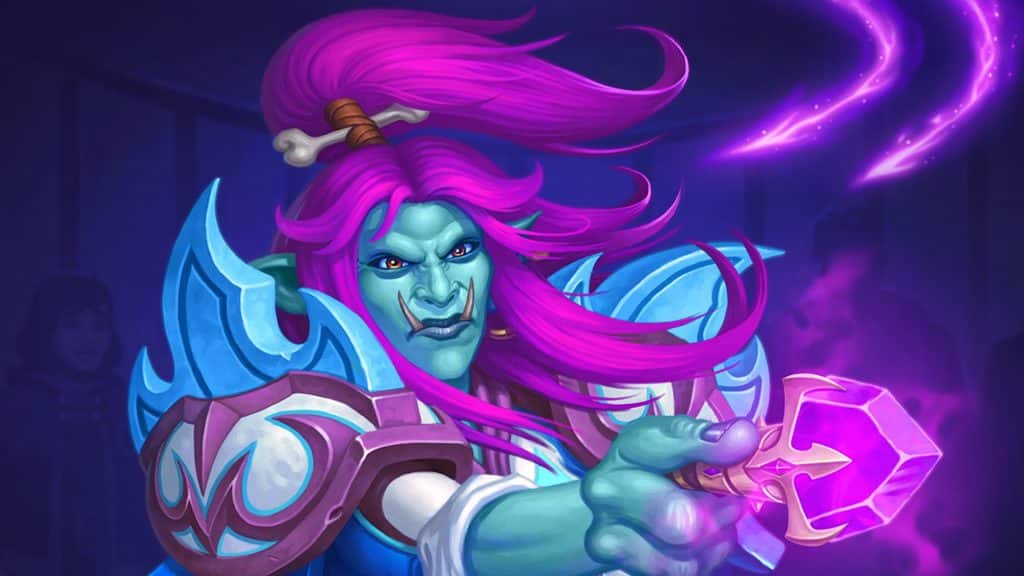
The newly-introduced Wailing Caverns miniset has introduced dramatic changes into the wild Hearthstone meta. We are SixJ (Peak Rank 3 in May 2021/Rank 1 in June 2021 with Mozaki Mage), Nhlnjfan1 (Peak Rank 5 with Mozaki Mage in May 2021), and BenFromWork (Peak rank 12 with Mozaki Mage in March 2021), and want to teach everyone reading this guide how to take advantage of the new meta with Mozaki Mage, and achieve your competitive Hearthstone goals.
Writers of this article:
SixJ Twitter: @jjjjjj_wildhs
Nhlnjfan1 Twitter: @nhlnjfan1_hs
BenFromWork Twitter: @BenFromWild
Table of Contents
Table of Contents
Decklist/Card Choices

The core deck is composed of cards that can be split into 4 categories: mana cheat, stall, cycle, and burn. Keep in mind there is overlap in some of these packages, as some cards fit in two categories (these are often your best cards). The cards in each package are listed below:


» Mana Cheat
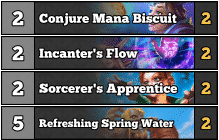
This is primarily composed of cards that help achieve your combo sooner. The most important of these is Incanter’s Flow, a must-play in the early turns. Conjure Mana Biscuit can be cast in the midgame to set up for a combo turn, or serves as an extra spell damage tick when both parts of the spell are played alongside Mozaki. Sorcerer’s Apprentice is usually dropped on the Mozaki turn, but can be played in fringe cases to stall opponents or set up for a combo turn. Finally, Refreshing Spring Water can regain mana when discounted by 2 or more. Although it’s uncommon, the extra mana can be very relevant when comboing and drawing into burn.

» Stall
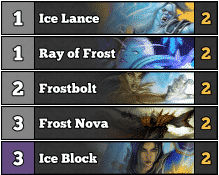
The stall package helps players get through the midgame without dying. Freeze effects like Ray of Frost and Frost Nova stop most damage to help extend Ice Block’s longevity. Ice Lance is also included thanks to its utility against weapon decks. Freezing a Kingsbane Rogue’s face can easily buy an entire turn. Frostbolt also works in these situations, but is generally better served as removal on certain early game minions and burst during the combo turn.

» Cycle
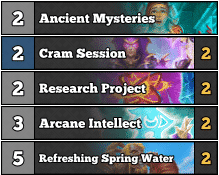
The core of the deck contains 9 cycle cards, 1 of which serves as a tutor. Ancient Mysteries is guaranteed to draw Ice Block, helping thin the deck and giving players an extra turn to reach their win condition. It is especially useful against Loatheb, as players will find that their 0 mana Ice Block will still be playable on a Loatheb turn. Arcane Intellect and Refreshing Spring Water serve as generic card draw, with Spring Water having the occasional upside of regaining mana. Research Project is usually played in the later turns, since giving an opponent more cards early on backfires more often than doing so in the lategame. The card also offers milling and fatigue options in slower matchups and the mirror. Lastly, Cram Session is primarily used as a reload during the Mozaki combo turn. This helps draw into any extra burst the player might need to end the game.

» Burn
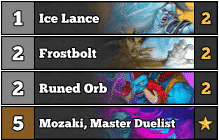
The 7 cards listed are fairly self explanatory. All of them are used during the combo turn to finish off opponents and win the game. As mentioned above, Ice Lance and Frostbolt are sometimes used to stall in earlier turns. Runed Orb is also sometimes useful as a last resort to discover more stall, cycle, or burn.

» Flex
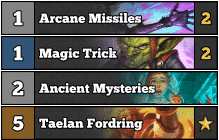
Most of the list has been settled on among players, but the final two slots have been up for debate. Many run a second Arcane Mysteries to increase the consistency of drawing Ice Block. Usually, players will also run Taelan Fordring alongside the second Mysteries. The appeal of Taelan is that it finds a minion every time. Usually, this will be Mozaki, but drawing a Sorcerer’s Apprentice is also useful. BenFromWork has cut the extra two tutors for two Magic Tricks. The Tricks offer extra discoveries for more stall, cycle, and burn; additionally, they can be cast for free to increase Mozaki’s spell damage on the combo turn alongside Sorcerer’s Apprentice. Players might also want to try Arcane Missiles. Though not necessary at all, the spell simplifies a lot of the math on the combo turn against opponents with Ice Block and offers even more damage against decks that gain armor or run Bulwark of Azzinoth.

Mulligan
Incanter’s Flow is the best card in your deck. Keep all copies of it, all the time, regardless of any other rules mentioned in this guide.
The best cards to keep vary pretty heavily from matchup to matchup, and mastering Mozaki Mage means having a solid understanding of what threats your opponent will put out and how best to counter them. The mulligan is also much easier in open-decklist matches (e.g. conquest series) or against opponents who you have seen before.
» Against aggressive decks
Ancient Mysteries/Ice Block are solid keeps, and in specific circumstances you can keep a piece of removal (for example, keeping Frostbolt when facing a Pirate Warrior on the coin). In cases when you already have a Flow, keeping a Biscuit against aggro can allow you to pop off almost immediately after getting Mozaki.
» Against control decks with combo disruption
(e.g. Renolock, Raza Priest): Mulligan hard for Flow, keeping a one-sided draw-two card (Arcane Intellect/Refreshing Spring Water) if you find one.
» Against control decks with minimal hand disruption
(e.g. Odd Warrior, Jade Druid, Big Priest): Follow the mulligan advice for control decks above, but also keep Mozaki/Taelan to tutor out your combo earlier. This is especially important against armor decks, where you need to maximize your damage output. These are matchups where Magic Trick really makes the greatest impact, often giving more than enough burn.
Gameplan
» Early Turns (1-3)
Very early on in the game, Mozaki has limited options: playing Incanter’s Flow, paying for the first half of a Mana Biscuit, pinging a 1hp minion, or using Frostbolt on a key 3hp minion (e.g. Ship’s Cannon, Malchezaar’s Imp). In certain cases, Coin ping can be correct even over Incanter’s Flow (for example, against a Handbuff Paladin that played Knight of Anointment on 1 to deny turn 2 Hand of Adal). Coin + Incanter’s Flow on 1 is almost never correct if you do not have a second flow in hand.
» Midgame (Turns 4-6)
There are a few main things you want to do in the midgame: cycle, manage board, manage hand size, and setup for your combo.
- Cycling
Stock lists run six draw-two cards, with Ancient Mysteries/Taelan as tutored draw. The more cards you can draw (especially with Incanter’s Flow cast), the faster you will get to your combo and OTK. Be careful with Research Project–only use it in situations when you expect to get more value out of it than your opponent. Managing hand size going into your draw turns (e.g. getting rid of a Ray of Frost with spare mana) is also very important. A discounted cram session almost guarantees you a win if played with Mozaki and Sorcerer’s Apprentice; do not use them unless you have a second copy in hand or it is absolutely necessary (for example, searching for Ice Block after your first copy was popped).
- Managing Board
How you manage your opponent’s board may vary from deck to deck, but the single most important piece of advice we can offer is this: delay the turn your opponents pop your first Ice Block as long as possible. Most of the popular decks on ladder (e.g. Handbuff, Darkglare) can very readily pop your Ice Block at 1 and put you on a two turn clock. Proactively using Frost Nova and freezes gives you extra turns to assemble your combo and kill your opponent. When you cannot efficiently delay a Block pop any longer, it’s time to abandon efforts to manage the board and focus fully on assembling your combo and finish the game after your two Ice Block turns. If possible, always try to boardlock your opponent instead of killing minions.
- Managing Hand Size
Mozaki Mage has a ton of draw (Six draw-two cards, two copies of Ancient Mysteries, Taelan, and two Cram Sessions), and between your minions and damage spells it is easy to get to ten cards in hand in the midgame. When managing your hand size and deciding which cards to get rid of, it is important to think a few turns down the line about what your opponent may play. Sometimes this may require getting rid of the coin at the end of a turn or using a freeze spell inefficiently, but making sure you don’t waste cards you need (e.g. a free ice block vs Darkglare Warlock when you have a full-cost one in hand) is much more important.
- Setting Up your Combo Turn
Setting up for your combo primarily involves looking for Mozaki + Sorcerer’s Apprentice, preparing Mana Biscuits, and holding a Cram Session for your combo turn. You should rarely play out your 1-mana Biscuits unless you need the extra mana for a specific reason (e.g. for a Frost Nova when lethal damage is on board, preparing for a turn six combo turn). All of your 1-mana spells are free with Mozaki + Sorcerer’s Apprentice, and playing more spells on the combo turn maximizes your damage output.
» The Combo Turn (Turn 5+)
Deciding how soon to play out your combo (especially when you need to draw into lethal) requires knowledge of the specific matchup you’re playing, and will be addressed in matchup guides. Your combo turns should always start with Mozaki alongside one or more copies of Sorcerer’s Apprentice, as you want to make sure that each of the spells you cast during this turn powers up Mozaki and that each spell is discounted. In many cases you’ll start by clearing cheap spells out of your hand, then use a powered-up Cram Session alongside other card draw to find your burn and ultimately kill your opponent. Playing playing cheap spells into a big Cram Session will usually give you enough burn or extra card draw to find lethal damage, especially if you have played an Incanter’s Flow, so don’t fret if you start a combo turn with limited burn in hand.
A note for mobile players/players with low APM: You cannot cast the second half of Ray of Frost or discover a spell off Runed Orb until all animations before that spell cast have resolved. Playing these at the beginning of your turn to avoid animation lag, or Runed Orb at the end of a chain of burn spells for lethal, are two ways to avoid losing to APM during your combo turns.
Match-Specific Mulligan and Gameplans
» General Aggro
Always Keeps: Incanter’s Flow, Ancient Mysteries, Ice Block
Secondary Keeps: Frostbolt (if deck can snowball with an early 3hp minion like Ship’s Cannon), Arcane Intellect/Refreshing Spring Water (if you have flow in hand)
As stated earlier in the guide, one of the most important things to think about against aggressive decks is how long you can keep your first ice block up. Pinging down 1hp minions, using your burn spells on minions with recurring effects (Ship’s Cannon, Underbelly Angler, Malchezar’s Imp), and proactively freezing the board are crucial to make time for you to set up a combo finisher. Against decks that like to flood the board (for example, Odd Paladin), saving frost novas to board-lock your opponent can be incredibly useful.
When you realize that you cannot delay a block pop for much longer, it’s time to stop using freezes/removal and go all-in on draw to look for your combo. Always have a plan for how you are going to handle Loatheb, especially if you are using a Research Project to cycle. Normally, this involves playing your more expensive Ice Block first and saving the copy you draw off Ancient Mysteries for the Loatheb turn. Ideally, by the time your second block is popped, you should find Mozaki, mana cheat, and enough draw/burn to take down your opponents.
» General Control (No Hand Disruption)
Always Keeps: Incanter’s Flow, Arcane Intellect, Refreshing Spring Water
Secondary Keeps: Mozaki/Taelan (keep if you are against a control deck that gains lots of armor or if the rest of your opening hand is strong against a deck that does not gain armor)
Against control decks with minimal hand disruption, you are very rarely going to be pressured on board. Between your abundant cycle and mana cheat cards effects, your main priority in these matchups should be assembling your Mozaki combo and ensuring that you will have enough damage to OTK your opponent. Be sure to manage hand space in these matchups to avoid milling combo pieces; this can often be done by playing out your extra freeze cards on whatever minions your opponent drops.
» General Control (With Hand Disruption)
Always Keeps: Incanter’s Flow, Arcane Intellect, Refreshing Spring Water
Against control decks with hand disruption (e.g. Dirty Rat, Mindrender Illucia), it is important to limit the amount of knowledge your opponent has about your hand to make it as hard as possible for them to effectively time it. For example, when facing decks without Illucia, playing Conjure Mana Biscuit with no minions or only a Taelan in hand can trick your opponents into dropping Dirty Rat prematurely and advancing your gameplan. The rest of your game plan should be similar to that used against other control decks–cycle hard, find your combo, and kill your opponent.
There may also be times when you may not have the time to wait to naturally draw Mozaki (for example, a Reno Shudderwock Shaman that has already played Loatheb or an LPG Mage that has cast its namesake spell); in these cases, you may have to drop Taelan and just hope that your opponent won’t punish you for it.
» General Combo
Always Keeps: Incanter’s Flow, (usually) Ancient Mysteries
Conditional Keeps: Arcane Intellect/Refreshing Spring Water with Incanter’s Flow, Taelan Fordring depending on rest of hand/opponent deck
Against combo decks, your primary objective is to race your opponent down as quickly as possible. This means mulliganing hard for the cards which will let you combo before your opponent. Typically, you can ignore early boards that your opponents produce (for example, an Injured Marauder from Oaken Summons) and focus on drawing to your own win condition.
» Demon Hunter
- Odd DH
See the General Aggro section of this guide. Runed Orb is a particularly useful way to get rid of their scaling 2hp minions.
» Druid
- Aggro/Embiggen Druid
See the General Aggro section of this guide
- Celestial Druid
In this matchup, getting Mozaki, a Sorcerer’s Apprentice, and card draw into your hand early is crucial. Your goal in the early game should be to draw aggressively and assemble a hand that will let you combo right after your opponent plays Celestial Alignment. You have a bit of time if the opponent is running a Malygos/damage-based win condition, but if your opponent is running a Togwaggle deck it will likely be necessary to combo immediately after your opponent plays Celestial Alignment. The mana discount from Sorcerer’s Apprentice means that every spell in your deck is free after celestial alignment, so Mozaki and card draw can easily give you the damage to burst through any amount of armor gain in the early turns.
- Jade Druid
See the General Control (No hand disruption) section of this guide for broad matchup tips. The only additional advice for Jade Druid matchup is that using one (or two, if needed) piece of burn to kill an early Archmage Vargoth. Losing 20 or so burst on the Mozaki turn is much better than seeing your opponent gain 70 armor with Vargoth + Ferocious Howl/Branching Paths. Another thing to be cognizant of in the Jade Druid matchup is Naturalize; it may not be possible to play around Solar Flare + Naturalize every turn, but trying to free up hand space by tossing Rays of Frost and Frost Novas before you have Mozaki in hand is an effective line to take against these opponents.
- Token Druid
Token druid normally takes a few turns to draw into Wispering Woods and Glowfly Swarm; use that time to cast Incanter’s flow + the first half of your Biscuits and draw towards Frost Novas. Between cards like Savage Roar, Mark of the Lotus, and Arbor Up, your opponents are likely going to pop your ice block the first turn they have a full, non-frozen board. Using your freezes proactively to keep your Ice Blocks up as long as possible will be critical as you assemble your combo
» Hunter
- Secret Hunter
Although Hunter has long been the weakest class in the Wild meta, Secret Hunter can pose a unique challenge to Mozaki Mage because it runs Pressure Plate. Treat the early game like you would handle any other aggro deck, but on the combo turn make sure to play Mozaki first (play around snipe), then 1-2 Sorcerer’s Apprentices, then spells. Make sure that you will have the mana to OTK even if an Apprentice dies.
» Mage
- Mozaki Mirror
Mulligan hard for Incanter’s Flow in this matchup. If you can get a Flow down first and cycle faster than your opponent, you tend to be in a very favorable position moving into the combo turn. As you get to the midgame, be very careful about your hand size in light of Research Project, and consider using Runed Orb proactively to look for Flow, cycle, or a Mage secret (even if it’s a useless secret like Oasis Ally or Flame Ward, your opponent is likely going to prematurely drop a Sorcerer’s Apprentice or use their mana suboptimally to play around Explosive Runes/Potion of Polymorph).
There are two ways to win this matchup in the late game:
Combo first, and pop your opponent’s two Ice Blocks before they can pop yours.
Ignore Ice Block and mill your opponent to death with Research Project.
If you have an early combo turn, be careful to manage your deck size well and make sure your opponent cannot fatigue you before you will get through their ice blocks. If you combo second, especially if your opponent played a big cram session, aim to fatigue them or skillfully discover an extra ice block or two to outlast your opponents.
- Reno Mage (LPG or Secret)
Reno Mages present a substantial challenge to Mozaki Mage; Ice Block denies lethal damage during your combo turn, and a combination of disruptive secrets (either from their deck or Arcane Keysmith), Loatheb + bounce effects, and Reno/devolving missiles make this matchup very difficult. Try to combo as early as you can; a turn 5 or 6 combo can make it extremely difficult for opponents to clear Mozaki and heal out of range from your remaining burn.
- Secret Mage
See the general aggro section of this guide. In addition to the advice there, make sure that you play around your opponents’ secrets in the midgame (e.g. Ray of Frost before Refreshing Spring Water/Frost Nova to test for counterspell). On your combo turn, ALWAYS play Mozaki first to play around Explosive Runes, and make sure to pop your opponent as close to 1hp as possible if they have a secret up to play around Ice Block. If your non-Reno Secret Mage opponent is running Potion of Polymorph, they’re running a suboptimal list – this scenario is so uncommon that it is just not worth playing around. Whenever possible, try to combo on or before the turn you cast your second Ice Block to make sure that you will survive an extra turn to deal the last damage to your opponent if they have an Ice Block up as well.
» Paladin
- Handbuff Paladin
See the general aggro section of this guide. Make sure to freeze proactively in this matchup, since Handbuff Paladin almost always can pop your second ice block and deal lethal damage from a frozen board. Another thing to keep in mind is that pinging early 1hp minions (even over playing Incanter’s flow) can stop your opponent from playing Hand of Adal, significantly slowing down their early game.
- Odd Paladin
See the general aggro section of this guide. This matchup is more favored than other aggro matchups because Odd Paladin boardlocks very easily. Save your Frost Novas to deny damage for a full turn, and freezing just one or two minions a turn once you get past Turn 5 can sometimes save your Ice Block for an extra turn if Conviction hits the wrong minions
» Priest
- Big Priest
See the General Control (No Hand Disruption) section of this guide. This is an almost-unloseable matchup for skilled Mozaki pilots.
- Raza Priest
It is almost impossible for Raza to mount enough pressure to beat you through direct damage, so the most common way they can steal games off Mozaki is through Dirty Rat and Mindrender Illucia. Keep Taelan in hand for rat protection, and try to give your opponent as little information as possible about the contents of your hand to make it difficult for them to effectively time their Mindrender Illucia. Don’t leave Mana Biscuits in hand, but beyond that there is not much you can do to play around a well-timed Illucia. Just assume your opponent does not have it, but try to avoid making your hand too tempting to steal (this may mean getting rid of the coin or a Mana Biscuit just to keep your opponent from playing it).
» Rogue
- Aggro Rogues (Odd, Kingsbane)
See the General Aggro section of this guide. Rogues tend to have a substantial amount of burst from hand between weapon buffs, charge minions, and damage spells, so make sure to play around that when trying to stop your Ice Blocks from getting popped.
- Mill Rogue
Between milling combo pieces, Evasion, Cloak of Shadows, and Valeera the Hollow, this matchup is almost unwinnable. After Mill Rogue games, curse your opponents for playing a toxic, uninteractive deck that stalls for five turns then hits you with unavoidable burst damage (yes, we know exactly what we said here).
» Shaman
- Aggro Elemental/Overload Shaman
See the General Aggro section of this guide.
- Even Shaman
See the General Aggro section of this guide.
- Murloc Shaman
See the General Aggro section of this guide.
- Big Shaman
Assume Ancestor’s Call won’t hit Mozaki (unless you can assemble the cards/mana to setup for an early OTK if Mozaki is pulled onto the board). If it doesn’t, play this matchup out like Big Priest.
- Galakrond Shaman
See the General Aggro section of this guide. Remember that Shudderwock will copy Loatheb’s battlecry if it was played earlier in the game, so be sure to combo before Shudderwock is played or prepare an answer for a potential second Loatheb turn.
- Control Shaman (Reno, Shudderwock)
See the General Control sections of this guide. Always play around Dirty Rat if you are facing a Reno deck, and do your best to play around the other disruption cards they may run (e.g. Mutanus, Loatheb). Try to combo as soon as you safely can to avoid losing to disruptive battlecry effects.
» Warlock
- Cube/Big Demon Warlock
See the General Control section of this guide. Not all lists run Dirty Rat/Demonic Project, but if you know or suspect that your opponent is running these tech cards be careful about playing out Taelan.
- Darkglare Warlock
Darkglare has terrorized the meta since Scholomance Academy, but Mozaki is one of the best decks to fight back against it. In addition to keeping Flow, it is important to look for Ancient Mysteries in the early game to get a free Ice Block. Do not play your zero-cost Ice Block until you are facing down lethal damage, have a second zero-cost Ice Block, or have already played a full-cost Block. It is absolutely essential to save your free block to use if your opponent pops your first block and plays Loatheb on the same turn. Some Darkglare lists are running Zephrys now, but in many cases Flare is so hard to play around that it’s just easiest to assume that your opponent does not have it
Outside of managing your Ice Block, a key aspect of this matchup comes down to delaying your opponent’s first Block pop. This may mean freezing giants instead of drawing in the midgame, using Frost Nova even before a big giants board has come down, or even using The Coin to ping a turn 1 Kobold Librarian to prevent its recurrent damage. You will either win by assembling the Mozaki combo on turn 5 to 7, or just by playing out burn cards without Mozaki if your opponent tries to play out their Molten Giants.
One final thing to keep in mind is that glare often does so much damage to itself that you can burn them down with frostbolt/ice lance in some cases. Always check your hand for lethal before committing to a stall gameplan.
- Discard Warlock
See the General Aggro section of this guide.
- Reno Warlock
See the General Control (With Hand Disruption) section of this guide.
» Warrior
- Charge/ETC Warrior
See the General Control (No Hand Disruption) section of this guide. Although these are combo decks, they are often much slower than you are. Beware of Dirty Rat in some ETC lists. Risky Skipper/Armorsmith has the potential to generate huge amounts of armor, so try not to leave those minions alive if you can handle them efficiently.
- DMH Warrior
See the General Control (Hand Disruption) section of this guide. Play around both Dirty Rat and Coldlight Oracle in this matchup. As mentioned above, be careful about the armor that can be gained through Risky Skipper turns.
- Odd Warrior
See the General Control (No Hand Disruption) section of this guide. In addition to this information, play around Coldlight Oracles wherever possible. If you have the opportunity to generate Arcane Missiles or any other cards that deal repeated damage, take them to play around a potential Bulwark of Azzinoth.
- Pirate Warrior
See the General Aggro section of this guide. Between Ship’s Cannon, Skybarge, Southsea Captain, Rokara, and weapons, Pirate Warrior has a wide arsenal of tools to put continuous pressure on you throughout the game. This is a particularly challenging aggro matchup for Mozaki to handle.
Conclusion
While there are many directions the Wailing Caverns meta may take after the Stealer of Souls ban, Mozaki Mage will almost certainly maintain the versatility and power level to succeed at any level of competitive Hearthstone. Whether you read this guide to learn how to pilot Mozaki Mage or hope that knowing what makes the deck tick will prepare you to beat it, we wish you all the best in the new meta. Feel free to reach out to us on Twitter if there is any information we missed or if you have further questions about the deck.
This Guide was written by:
- jjjjjj/SixJ, a regular high legend wild Hearthstone player and lover of all things combo.
- Nhlnjfan1 has been a Wild Hearthstone regular since Journey to Un’Goro, and he has numerous high legend finishes in Wild. When he’s not playing hearthstone, you can find him in his quiet New Jersey home.
- BenFromWork is a regular standard and wild legend player who has hit rank 1 multiple times.
Do you want to have your work featured on Hearthstone-Decks.net? Email us at neon31HS@gmail.com, and we’ll talk! Also, feel free to join our Discord, or follow us on Twitter or Facebook. You can also support us on Patreon!
You might also be interested in...
Submit your Top 500 Legend Build, be seen by thousands of people!
Check out the Bazaar "the first free to play Hero-Builder for PC and Mac" Beginner's Guide! https://bazaar-builds.net/the-ultimate-beginners-guide-to-the-bazaar-tips-strategies-and-more/

